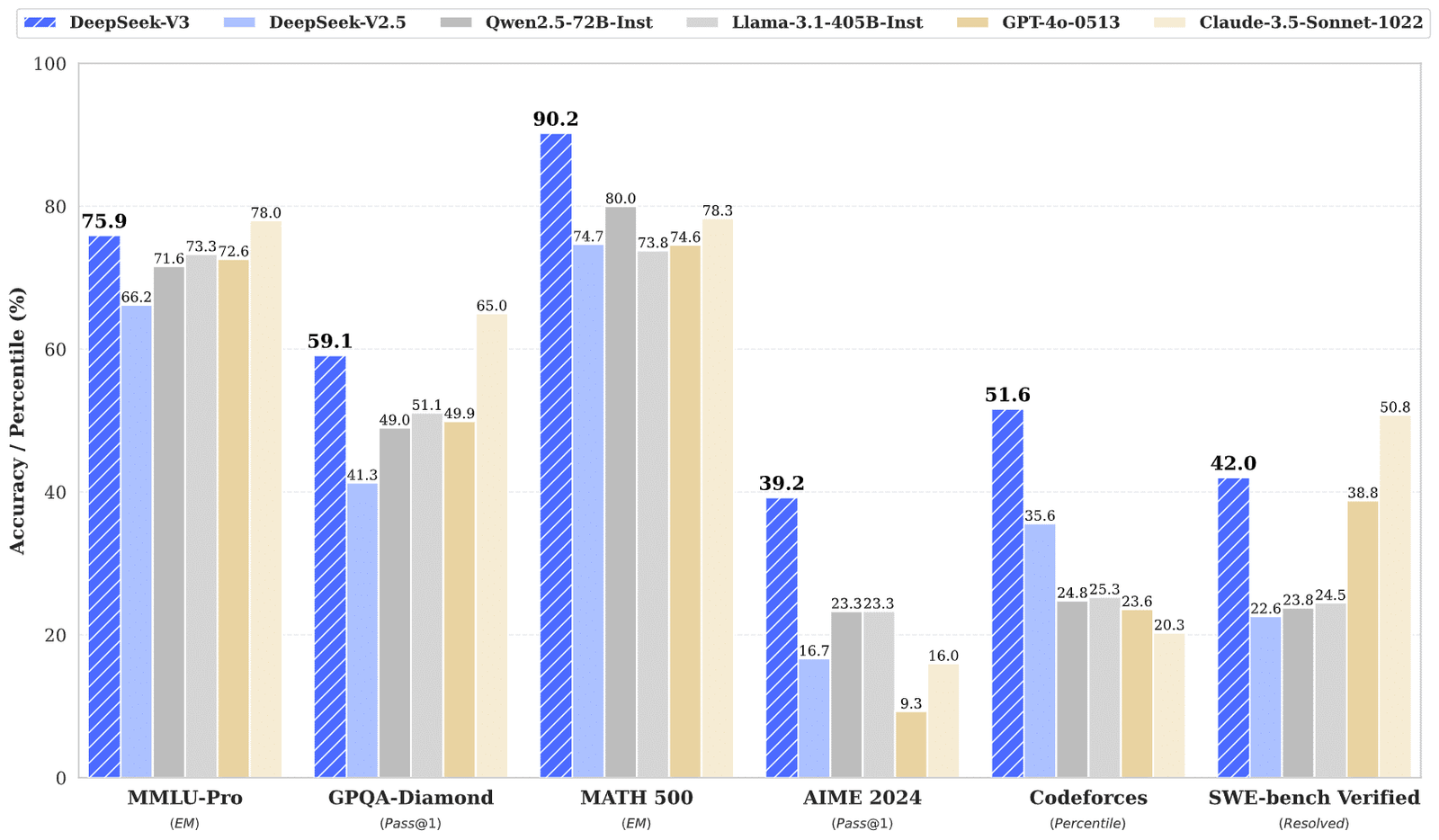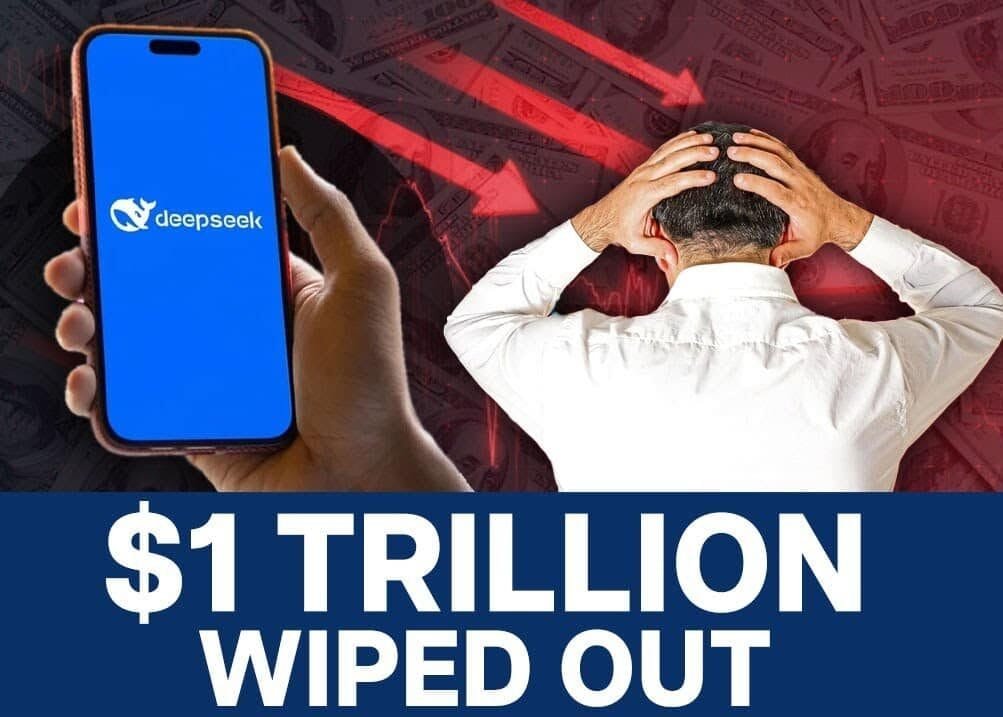USA Falling Behind in AI? China’s DeepSeek V3.1 Challenges GPT-4
Introduction: A New AI Battle Unfolds
China is rapidly advancing in artificial intelligence, and its latest innovation, DeepSeek V3.1 (0324), is making waves in the AI community. With superior reasoning, coding, and UI generation capabilities, DeepSeek V3.1 is emerging as a strong competitor to GPT-4-Turbo and Claude 3.5 Sonnet. Is the U.S. losing its dominance in AI development? Let’s dive into the details.
DeepSeek V3.1: A Game Changer?
DeepSeek V3.1 is designed to excel in several areas, including logical reasoning, coding, and mathematical problem-solving. Here are its standout features:
Model Downloads
| Model | Total Params | Activated Params | Context Length | Download |
|---|---|---|---|---|
| DeepSeek-V3-Base | 671B | 37B | 128K | Hugging Face |
| DeepSeek-V3 | 671B | 37B | 128K | Hugging Face |
1. Advanced Reasoning & Logic
DeepSeek V3.1 follows a multi-step approach to problem-solving, making it more analytical than traditional AI models. It handles complex reasoning questions like:
- “How many R’s are in ‘strawberry’?” – Accurately counts and verifies.
- “How many times can you subtract 10 from 100?” – Recognizes the mathematical implications of subtraction.
- Time-based riddles – Successfully answers logic-based time-travel questions.
This structured reasoning sets it apart from models that generate direct responses without explanation.
2. Impressive Coding & UI Generation
DeepSeek V3.1 performs exceptionally well in coding tasks, particularly in front-end and UI development:
- SVG Graphics: Can generate detailed vector graphics.
- HTML & JavaScript: Successfully builds functional projects, such as a working snake game with real-time scoring.
- Mathematical Processing: Displays strong symbolic reasoning in solving equations.
It also integrates AI-assisted UI components, making it ideal for web developers and designers.
3. Strong Benchmark Performance
DeepSeek V3.1 has ranked highly in industry benchmarks:
- #3 on K-Coder LLM Arena, just behind Claude 3.5 Sonnet and Claude 3.7 Sonnet.
- Competes closely with Qwen 32B, especially in coding efficiency.
- Lacks official documentation, requiring external validation for real-world use.
Despite its strong ranking, DeepSeek V3.1’s lack of official documentation means developers must rely on community-driven testing to evaluate its true capabilities.
DeepSeek V3.1 vs. GPT-4-Turbo vs. Claude 3.5 Sonnet
How does DeepSeek V3.1 compare to the leading AI models? Here’s a detailed breakdown:
| Feature | DeepSeek V3.1 (0324) | GPT-4-Turbo | Claude 3.5 Sonnet |
|---|---|---|---|
| Reasoning & Logic | Multi-step reasoning | Strong contextual understanding | Analytical & logical |
| Coding Capabilities | Good at UI & game dev | Advanced & precise | Well-structured code |
| UI Generation | SVG, HTML, JS support | Limited UI design | Limited UI design |
| Mathematical Processing | Strong symbolic reasoning | Excellent at math | Strong problem-solving |
| Benchmarks Ranking | #3 on K-Coder Arena | Top-tier model | Close to GPT-4 |
| Official Documentation | Limited | Well-documented | Moderate documentation |

Summary of the comparison table
DeepSeek V3.1 is emerging as a strong competitor to GPT-4-Turbo and Claude 3.5 Sonnet, particularly in reasoning, coding, and UI generation. It excels in multi-step logical reasoning, solving complex problems with structured analysis, unlike GPT-4-Turbo, which emphasizes contextual understanding, and Claude 3.5 Sonnet, which is highly analytical.
In coding, DeepSeek V3.1 performs well in UI and game development, supporting SVG graphics, HTML, and JavaScript, whereas GPT-4-Turbo is more precise in general coding, and Claude 3.5 Sonnet focuses on structured code generation. For mathematical reasoning, GPT-4-Turbo leads, but DeepSeek V3.1 and Claude 3.5 also showcase strong problem-solving abilities.
DeepSeek V3.1 ranks #3 on the K-Coder LLM Arena, trailing behind Claude 3.5 and Claude 3.7. However, its lack of official documentation limits accessibility compared to GPT-4-Turbo, which is well-documented.
China’s AI advancements, backed by government support and vast datasets, indicate a growing challenge to U.S. AI dominance. While DeepSeek V3.1 is not yet at GPT-4’s level, its rapid improvements suggest that China is closing the gap. Future updates could make it a more formidable competitor in the AI landscape. 🚀
The AI Arms Race: Can the U.S. Keep Up?

The rapid rise of DeepSeek V3.1 signals China’s growing influence in AI development. While the U.S. continues to lead with OpenAI, Google DeepMind, and Anthropic, China’s investments in large-scale AI models are paying off. Key developments to watch include:
- Future iterations of DeepSeek – Will it close the gap with GPT-4?
- China’s AI regulations – Will government policies accelerate or hinder innovation?
- U.S. advancements – OpenAI and Google must continue pushing boundaries to maintain leadership.
China’s AI Growth: A Strategic Push
China’s AI push is backed by government support and vast data access. Key factors contributing to its rapid progress include:
- Massive investment in AI research and infrastructure
- State-backed AI initiatives driving innovation
- AI talent recruitment from global tech firms
- Access to enormous datasets for training
With such aggressive AI development, China is positioning itself as a leader in the next wave of AI breakthroughs.
Challenges for DeepSeek V3.1
While DeepSeek V3.1 shows promise, it faces several challenges:
- Limited access to Western markets – Many global companies still favor U.S.-based AI solutions.
- Lack of official documentation – Slows down adoption among developers.
- Ethical concerns – AI regulations differ widely between China and the U.S.
Final Thoughts: The AI Race Heats Up
While GPT-4-Turbo remains the most advanced AI model, DeepSeek V3.1 proves that China is a serious contender. With continued improvements, it could disrupt the AI landscape and challenge U.S. dominance. As AI technology evolves, keeping an eye on China’s next moves will be crucial for developers, businesses, and policymakers worldwide.
Stay tuned for more AI updates!
Related Article: How Google Gemini is Impacting Robotics Jobs – Explore how AI advancements like Gemini are reshaping the future of automation and employment.










